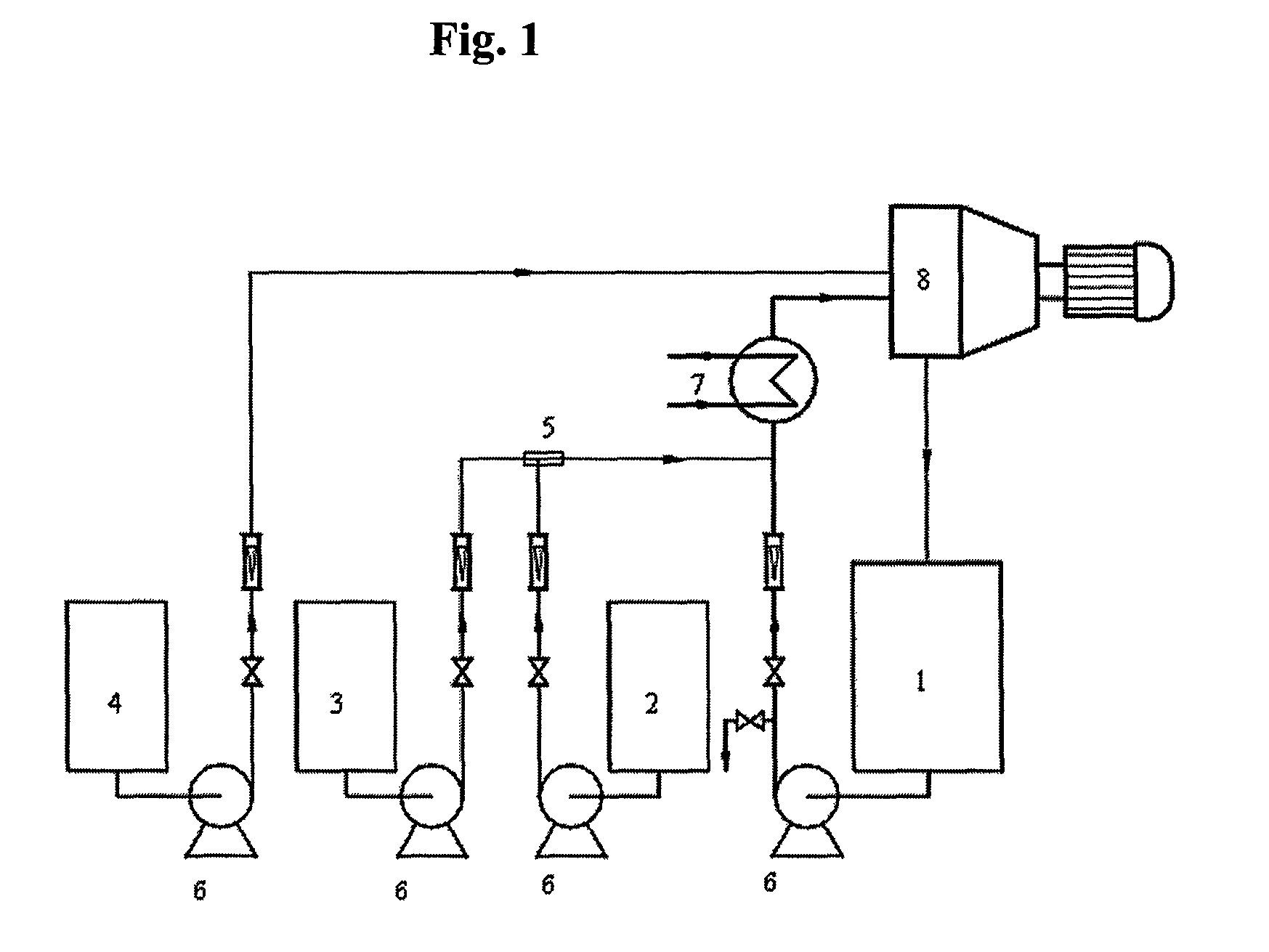Method of preparing polymethylene-polyphenyl-polyamine
a polyphenylpolyamine and polymethylene technology, applied in the field of preparing polymethylenepolyphenylpolyamine, can solve the problems of local excess of formaldehyde, affecting the quality of the targeted polyamine, and deteriorating the mixing effect accordingly, so as to reduce the impurities in the dam, rapid and uniform dispersion of formaldehyde, and strengthen the dispersion of formaldehyde
- Summary
- Abstract
- Description
- Claims
- Application Information
AI Technical Summary
Benefits of technology
Problems solved by technology
Method used
Image
Examples
example 1
[0040]Hydrochloric acid (a concentration percentage by weight is 30.8%, this hydrochloric acid is a by-product from MDI apparatus) from storage tank 2 and aniline from storage tank 3 are fed into venturi mixer 5 by a pump 6 with a molar ratio of hydrochloric acid / aniline=0.36:1, for mixing and reacting with each other to produce aniline hydrochloride which is then pumped into circulation pipes and mixed with a circulation solution coming from a condensation stirred vessel 1 to obtain a mixed solution. The obtained mixed solution is introduced into a heat exchanger 7 to remove the reaction heat, and the mixed solution, which is cooled to 38° C. and left the heat exchanger 7, is introduced into a feeding port of the high gravity rotating bed reactor 8 of rotating packed bed type. Formaldehyde solution (a concentration percentage by weight is 37 wt %) stream from storage tank 4 is fed through another feeding port of the high gravity rotating bed reactor 8, the ratio of formaldehyde to ...
example 2
[0041]Hydrochloric acid (at a concentration of 30.8 wt %, this hydrochloric acid is a by-product of MDI apparatus) from storage tank 2 and aniline from storage tank 3 are fed into venturi mixer 5 by a pump 6 with a molar ratio of hydrochloric acid / aniline=0.36:1, for mixing and reacting with each other to produce aniline hydrochloride which is then pumped into circulation pipes and mixed with the circulation solution coming from a condensation stirred vessel 1 to obtain a mixed solution. The mixed solution is introduced into a heat exchanger 7 to remove the reaction heat, and is, after being cooled to 39° C., further introduced into a high gravity reactor 8 of rotating packed bed type. Formaldehyde solution (at a concentration of 37 wt %) stream from storage tank 4 is fed into through other feeding port of the high gravity rotating bed reactor 8, the ratio of formaldehyde to aniline is controlled at 0.46:1. The formaldehyde solution is mixed sufficiently with the previously mixed so...
example 3
[0042]Hydrochloric acid (at a concentration of 30.8 wt %, this hydrochloric acid is a by-product of MDI apparatus) from storage tank 2 and aniline from storage tank 3 are fed into venturi mixer 5 by a pump 6 with a molar ratio of hydrochloric acid / aniline=0.38:1, for mixing and reacting with each other to produce aniline hydrochloride which is then pumped into circulation pipes and mixed with the circulation solution coming from a condensation stirred vessel 1 to obtain a mixed solution. The mixed solution is introduced into a heat exchanger 7 to remove the reaction heat, and is, after being cooled to 39° C., introduced into a high gravity reactor 8 of rotating packed bed type. Formaldehyde solution (at a concentration of 37 wt %) stream coming from storage tank 4 is fed into the high gravity rotating bed reactor 8 through other feeding port, the ratio of formaldehyde to aniline is controlled at 0.34:1. The formaldehyde solution is mixed sufficiently with the previously mixed soluti...
PUM
| Property | Measurement | Unit |
|---|---|---|
| temperature | aaaaa | aaaaa |
| reaction temperature | aaaaa | aaaaa |
| temperature | aaaaa | aaaaa |
Abstract
Description
Claims
Application Information
 Login to View More
Login to View More - R&D
- Intellectual Property
- Life Sciences
- Materials
- Tech Scout
- Unparalleled Data Quality
- Higher Quality Content
- 60% Fewer Hallucinations
Browse by: Latest US Patents, China's latest patents, Technical Efficacy Thesaurus, Application Domain, Technology Topic, Popular Technical Reports.
© 2025 PatSnap. All rights reserved.Legal|Privacy policy|Modern Slavery Act Transparency Statement|Sitemap|About US| Contact US: help@patsnap.com

